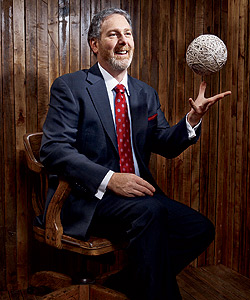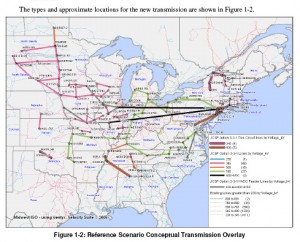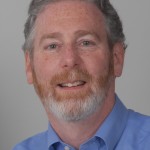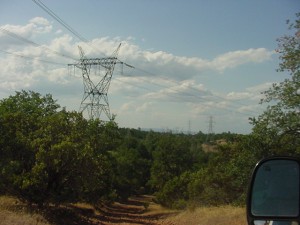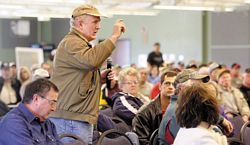Wind up to ELPC Transmission Strategy Meeting
March 28th, 2010
And the pitch? Nothing new, just RE-AMP toadying for utilities, but I’m waiting for Howard “The Slow” Learner to prove me right, again… and to see how far they go to promote transmission.
April 20 & 21st is Learner’s/Environmental Law & Policy Center‘s and RE-AMP’s “invitation only” transmission strategy workshop, at their office in Chicago, and I surmise much about their goal and strategy based on my many past experiences with transmission promoters. This meeting is very unlike the Sierra Club transmission strategy meeting in West Virginia last spring, a great group of people who understand the purpose of transmission, were actively engaged in fighting it and who have been successful in slowing down that big web of 500kV/765kV lines known as Project Mountaineer. Here in the Midwest, it’s a little different. An example:
What is ELPC doing to develop and expand transmission? Transmission lines across South Dakota moving this power out of state means it comes into Minnesota — funny how that works. What is ELPC doing about the coal plants in queue in the Dakotas?
What is the goal of ELPC’s invitation-only Transmission Strategy Meeting?
Anyway, it was no surprise to me — Learner saw I was on the list and has slammed the door in my face! Imagine that! SNORT! It seems that people with a lot of working knowledge of transmission, knowledge of history, and knowledge of the parties involved are not welcome. Specifics on this meeting are below.
Don’t drop the ball, Howard! Will Howard Learner and ELPC be the utilities’ water boy for transmission that’s planned stretching from the Midwest to the East Coast or acknowledge that more big transmission is not needed or wanted? And why would anyone want to advocate for transmission to the East Coast if the East Coast doesn’t want it? Will they respect the East Coast’s solid “NO!” to Midwest transmission? How ethno-geo-centric will they be?
Here are a few posts with links to the primary documents of NYISO & ISO-NE, NY’s Deputy Secretary of Energy, the 10 Mid-Atlantic Governors letter, etc.
DUH… eastern states don’t want our transmission
Offshore transmission, NOT transmission from Midwest
Eastern Governors stand up against Transmission!!!
The windup? Today’s Chicago Tribune has a disturbing article about transmission, foreshadowing the meeting three weeks from now:
For example, from the article:
The estimated cost to move that wind power east could range from $64 billion to $93 billion in 2009 dollars and would require 17,000 to 22,000 miles of transmission lines to be built in the eastern half of the country alone, according to the Eastern Wind Integration and Transmission Study (EWITS) published in January and prepared for the National Renewable Energy Laboratory.
Just a reminder, Matt Schuerger who worked on this EWITS (or “nitwits”) study is the same one who, together with Beth Soholt, asked me and several others to sell out on the SW MN 345kV line. At that time, he was at ME3 (after a stint at District Energy) and is listed as a consultant on Izaak Walton 990s, and Beth Soholt, Izaak Walton League (formerly of MAPP). FYI – Wind on the Wires is a GRANT, not an organization — it’s listed on the Izaak Walton 990s as a “program” despite having a Minnesota non-profit established (CLICK HERE for Secretary of State link). From May, 2001 NWCC minutes:

Matt Schuerger is, in 2022, a 2nd term Commissioner at Minnesota PUC (notice his bio doesn’t mention his working for Waltons, ME3/Fresh Energy, and Wind on the Wires!).
Color me naive, I really didn’t have a clue (other than the enviros’ obscene deal on Prairie Island in 1994) until that meeting in question, it was on or about Sept. 8, 2001, when Beth and Matt asked about 6-7 of us who were likely intervenors in that docket to sell out. “What would you need to approve of this line?” (the SW MN 345kV line, PUC Docket 01-1958). I asked what they were getting and what they’d share, and what they were getting was pissy and they got pissier the more questions I asked, particularly Matt, who made empty threats about walking out — DUH, please, leave! The most important question they didn’t address was, “What about the big long list of coal in queue on p. 29 of the study, waiting for the transmission that they were promoting?” Defensive pissyness, unwillingness to address the big picture, and silence. Schuerger and Soholt, they were so B Squad about it that afternoon at the Loring Cafe, Dinkytown, in 2001. That was the year that “Wind on the Wires” got $4.5 million to promote transmission. That amount was ramped up for the next grant, and the focus of their deal became clear when one agreement was posted on the TRANSLink docket. A o coupfle days later, “Wind on the Wires” got an Energy Foundation/McKnight grant of $8.1 million. $8.1 MILLION! Hmmmmm…
The Energy Foundation/McKnight funded and orchestrated promotion of transmission has been shameless, as bad as the enviro support for coal gasification, their transmission efforts ranging from attempts to gain endorsement of the regional SEED group (organizations that as a whole knew nothing about transmission) to legislative “it’s a deal, a package deal and it’s a good deal” changes desired by utilities, to NWCC “concensus building” to supportive intervention in transmission dockets. That agenda continues despite clear evidence that midwest transmission supports coal, our RES that does not link an increase in renewables with a decrease in coal, MISO policy that has a goal of displacing natural gas with coal (see “Conclusions” in ICF – Midwest ISO Benefits Analysis) , and decreased demand and a conservation mandate, such that transmission is not needed now and probably not needed ever. Whose interests are these organizations acting in? Their interests, their funders’ interests. Where’s consideration of the public interest?
What did they agree to back then? Here’s one example that’s public:
Take a closer look at “Wind on the Wires” that is a subset of the Izaak Walton League. Do members and chapters of the Izaak Walton League have a clue what this organization is advocating? Though there is a Minnesota “non-profit” registered, as above, it remains a “program” on the Izaak Walton League IRS 990s and Beth Soholt is an employee of the Waltons. From the website, here’s the address, same as the Waltons:
Office Location
Wind on the Wires
1619 Dayton Avenue, Suite 203
St Paul, MN 55104
(651) 644-3400
Their list of WOW Staff and Consultants:
Beth Soholt
Director, Wind on the WiresLinda Brewster
Administrative Associate, Wind on the WiresMatthew Schuerger, P.E.
Technical ConsultantNatalie McIntire
Technical/Policy Consultant
And take a look at who is on the board of “Wind on the Wires”, why the whole family is there:
Board Members
R.T. “Hap” Boyd
GE EnergyHans Detweiler
American Wind Energy AssociationJoe DeVito
RES – AmericasTom Feiler
Clipper WindpowerRichard Free
John Deere Wind EnergyBob Gough
Intertribal Council on Utility PolicyIan Krygowski
enXcoHoward Learner
Environmental Law and Policy CenterKevin Lynch
IBERDROLA RENEWABLESMichael Vickerman
RENEW Wisconsin
(And would you look at that, Rick Free?!?! Too funny — I’ve got to tell Nancy Prehn what Rick Free is up to since we killed his Simon Industries gas plant in Waseca!)
And the pitch:
The ELPC Midwest Transmission Strategy Meeting. The shameless Energy Foundation funded (and is this also McKnight Foundation funded?) and orchestrated promotion of transmission continues. First, on March 5th this appeared in my inbox:
Colleagues –
1. We appreciate the Energy Foundation’s grant support to cover reasonable travel/hotel costs for individuals and organizations that may need assistance in order to attend this important regional meeting.
2. Please call/email Kay Tamillow at ELPC (312-795-3709, ktamillow@elpc.org) for information on the favorable hotel rate that ELPC has obtained and to make reservations.
3. Please RSVP to attend if you’re interested and have not yet done so.
Best wishes,
Howard
———————————Midwest/Great Plains Environmental, Clean Energy and Consumer Colleagues,
Please join us for a Midwest Transmission Strategy Meeting on April 20 (dinner) and April 21 (full day), 2010 in Chicagoat the Environmental Law & Policy Center’s conference space, 35 East Wacker Drive. New major interstate transmission lines in the Midwest/Great Plains are a double-edged sword: On the one hand, they can provide additional needed delivery capacity for wind power and other new renewable energy development; on the other hand, they can provide enabling delivery capacity and lifelines of support for the continued operation of old highly-polluting coal plants. We will be developing strategies to advance the former and avoid the latter. We will also address important cost-allocation issues for new transmission. Please RSVP to Kay Tamillow at ktamillow@elpc.org or 312-795-3709. More info to follow on hotel, etc.
The purposes of the strategy meeting are to: (1) Bring together Midwest environmental, clean energy and consumer leaders to learn together and get up-to-speed on key transmission strategy and policy issues, (2) Set the strategic framework for what types of transmission lines we will support and which not, and what we can and should do through advocacy; and (3) Initiate strategic discussions and actions on high-leverage transmission advocacy targets in the Midwest/Great Plains states.
The importance of new transmission capacity to support wind power development is relatively clear. There is a less obvious and equally important goal of relating transmission advocacy to spur the retirement of old, highly-polluting coal plants in the Midwest/Great Plains states. There is a very important set of strategic leverage points because of the structure of the Midwest/Great Plains power market in 2010 – 2020.
The framework for the agenda is as follows below. We will distribute a final agenda closer to the meeting date.
April 20th, 5:30 pm. – 8:30 pm:
Dinner Meeting and Briefing with wind industry and transmission line developers presenting.April 21st, 8:30 am – 4:30 pm:
Morning: Strategy briefing and short course on key transmission issues and opportunities for environmental, clean energy and consumer advocates.Afternoon: Strategy planning and discussion on: (1) Engagement/intervention in key policymaking forums: FERC, MISO, State PUCs, Public Outreach; and (2) Focus on Pros/Cons and potential challenges to particular transmission line proposals in Midwest/Great Plains region.
The agenda planning group includes:
Citizens Utility Board (Illinois) – David Kolata
Energy Foundation – David Wooley and Ben Paulos
Environmental Law & Policy Center – Howard Learner and John Moore
Fresh Energy – Michael Noble
Kresge Foundation – Lois DeBacker
Michigan Environmental Council – James Clift
Wind on the Wires – Beth SoholtPlease RSVP to Kay Tamillow at ktamillow@elpc.org or 312-795-3709. More info to follow on hotel, etc. ELPC is working to obtain foundation support to cover reasonable travel costs for individuals and organizations that may need assistance. Please indicate in your response if you will need reimbursement of reasonable travel costs.
We all understand the strategic importance of this meeting and the issues to be discussed. Thank you in advance for you participation and engagement. Please let me know if you have any questions or suggestions.
Best wishes,
Howard
Howard A. Learner
Executive Director
Environmental Law & Policy Center
35 East Wacker Drive, Suite 1300
Chicago, Illinois 60601
email: HLearner@elpc.org
phone: (312) 673-6500
Please visit ELPC’s website at www.elpc.org
And of course knowing what they’re up to, I signed right up right after I got it, and Alan did too. We’re all set! Then, on the 16th, I get this, from Howard Learner:
Howard Learner wrote:
Carol and Alan,
I’m writing to let you know that the Transmission Strategy Meeting on April 20-21 is a “by invitation only” strategy session among a group of directly invited environmental – clean energy – consumer colleagues, rather than an open conference or seminar event. Members of the planning group for this particular strategy session have asked that we limit attendees to those directly invited. Although my assistant Kay Tamillow did receive your RSVP, we’ll ask that you not plan to attend.
Thank you for understanding,
Howard
Howard A. Learner
Executive Director
Environmental Law & Policy Center
35 East Wacker Drive, Suite 1300
Chicago, Illinois 60601
email: HLearner@elpc.org
phone: (312) 673-6500
Please visit ELPC’s website at www.elpc.org
So here’s my response to Howard’s email:
Howard –
Interesting — I think I understand some things and don’t understand others. I do know that I am thinking that the “plan” is getting more and more interesting…
The Sierra Club had an excellent transmission strategy planning meeting in West Virginia last spring of those intervening in transmission dockets, attorneys, expert witnesses, and advocates from both coasts regarding their focused and effective efforts. I think I shall regard your missive as confirmation that your strategic plan and goal is quite different from that of Sierra.
But many questions remain…
Carol A. Overland
Attorney representing clients in transmission cases across the country for 15 years now
We’ll see how this goes!
TANC is tanking, two more cities withdraw
July 14th, 2009
Just heard from Lisa Goza, of Stop TANC, that Modesto and Turlock dropped out, following SMUD’s withdrawal last week. That’s supposedly 70% of the $$$$ for the project — gone! Redding is hanging in there, but the STOP TANC crew is on them and… well… maybe tomorrow morning at the TANC board meeting, they’ll give it up, throw in the towel, and tank TANC. It’s so close…
This group is amazing, so many people spread out over such a great distance, and they’re so wildly diverse, united against this obscene project built on lies — they’ve exposed the TANC project for what it is, and it is falling… this is a case study in how to organize for impact.
Soon… it’s time for the silver stake!
Yolo supervisors reject transmission power lines
By LIZETH CAZARES/Lcazares@dailydemocrat.com
Created: 07/14/2009 03:49:59 PM PDT
Two more players drop out of TANC proposal
The Economist weighs in, now it’s YOUR turn!
May 4th, 2009
I’d wondered why “The Economist” had shown up in my blog stats, and now I know. But from the viewpoint of this article, it’s clear they didn’t do more than scratch the surface of transmission in the Midwest. This is “party line” all the way — I hope they’ll now take the time to read NYISO and ISO-NE’s letter of withdrawal from publication of JCSP!
YOUR TURN! Let them know what you think and why — the registration is instantaneous and easy, so COMMENT AWAY!
Spreading green electricity: A gust of progress
Apr 30th 2009 | CHICAGO
From The Economist print edition
Art Hughes has died…
March 31st, 2009
I’ve just received a missive from Iowa that Art Hughes, Ph.D. in Power Engineering, died last month, February 17, 2009.
Bernard A. Hughes
He was born on April 3, 1945, in Hereford, United Kingdom, son of James R. and Sara (Price) Hughes.
Art died just a few days after this photo was taken. He was making comments at a public meeting about an ITC transmission line through his Peosta, Iowa neighborhood:
Hearing generates electricity
Dubuque County landowners express concern about ITC transmission line
By MICHAEL SCHMIDT TH staff writerPEOSTA, Iowa — Jack Ludescher has second thoughts about his retirement home.
During the question-and-answer session, property owners voiced their concerns about the project.
Doug Behnke, of Peosta, questioned how energy from the transmission line would be neutralized.
Behnke scoffed at ITC’s graphic, calling it “distortion.”

